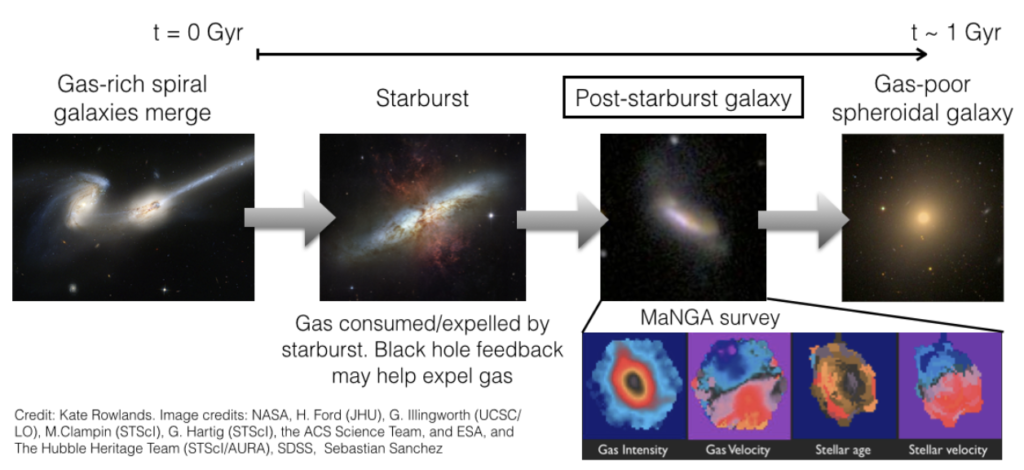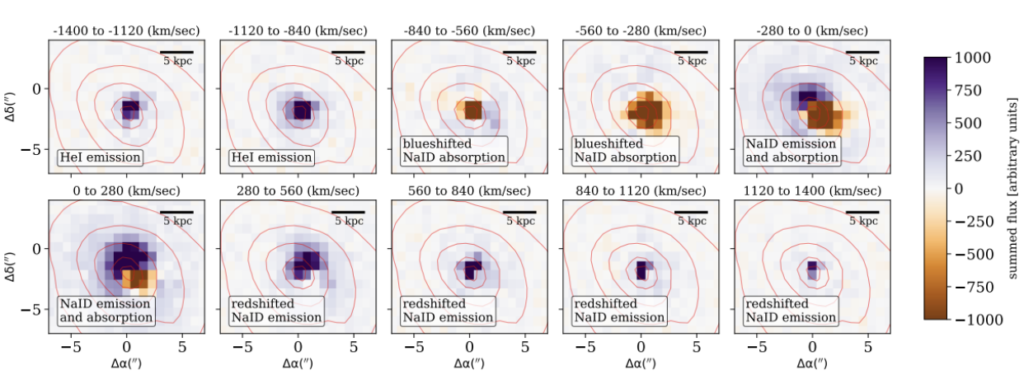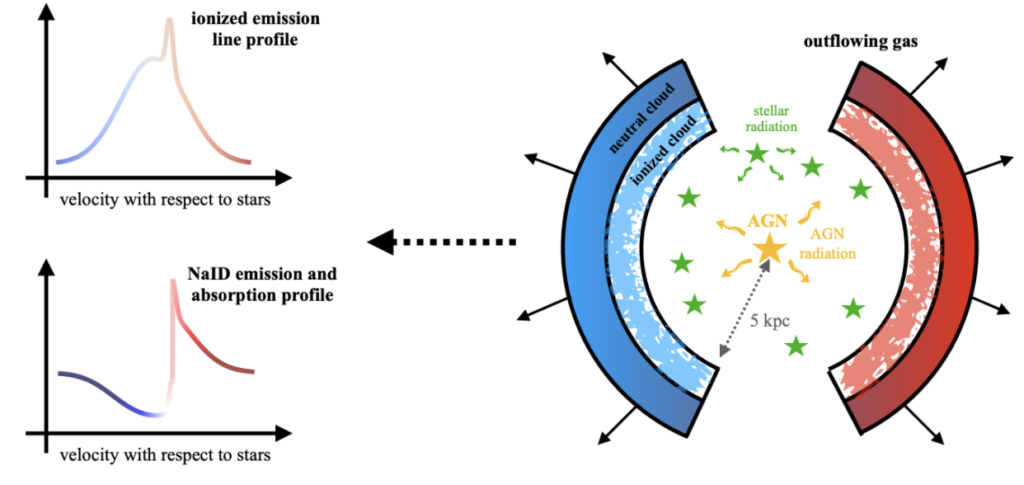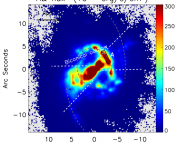Title: Multi-phase outflows in post starburst E+A galaxies – II. A direct connection between the neutral and ionized outflow phases
Authors: D. Baron, H. Netzer, R. I. Davies, J. Xavier Prochaska
First Author’s Institution: School of Physics and Astronomy, Tel-Aviv University
Status: Accepted to MNRAS, open access on ArXiv
Seminal work beginning in the early 2000’s introduced a surprising and deeply puzzling phenomenon: although central supermassive black holes are about the size of the solar system and typically make up less than 1% of the galaxy total stellar mass, their masses are extensively and intimately correlated with observed properties of their host galaxy. Bulge luminosity and mass, as well as the velocity dispersion (randomness of the stellar orbits) appear to be greater in galaxies with more massive central supermassive black holes. Understanding this relationship appears to be a key stepping stone in forming a comprehensive picture of galaxy evolution as a whole.
Observations and simulations alike have endeavored to discover the causal mechanism linking galaxy properties and black hole mass. Gas outflows ejected by AGN accretion activity have been a leading contender. They drive gas out of the nuclear region of the galaxy which may have otherwise been available to form stars or to feed the accretion of material about the black hole. The wider implication is the suppression of star-formation (quenching) of the galaxy at large by starvation of cold molecular gas.
This functional picture of the link between AGN activity and galaxy growth begs for a focused study into the behavior and composition of these outflows.

Direct measurements of the cold molecular hydrogen gas in outflows are next to impossible since the emission from the molecular gas is extraordinarily faint and usually can only be estimated through a tracer material such as dust. However, these outflows appear to be multi-phased. That is, containing cold molecular, as well as the more easily observable atomic, and ionized gas. While the ionized gas can be traced from emission lines, the neutral atomic components may be measured with ionized tracers.
Although mapping the spatial extent of these outflow phases is useful in itself, incredibly more difficult measurements such as the kinematics of the outflowing material and gas phase composition would be incredibly enlightening as it could help us understand the precise mechanics driving the outflow, as well as its origin, duration, and effect on the galaxy’s ability to grow.
The authors of today’s astrobite present such a study of the kinematics of a multiphase outflow.
They chose a particular class of galaxy as their target of study: post-starbursts. Post-starbursts are identified by a lack of young, blue O and B type stars, indicative of a recent suppression of star-formation in a massive starburst event. They have been theorized as near-ubiquitous consequences of gas-rich mergers, which have been also strongly linked to AGN activity (since the merging gas can be funneled in the central region where the supermassive black hole resides). For these reasons, post-starburst galaxies make excellent laboratories for studying these AGN-driven outflows.
The authors observe the post-starburst galaxy poetically named SDSS J124754.95-033738.6 with the MUSE instrument at ESO’s Very Large Telescope. MUSE is an integral field spectrograph, which provides contiguous spatially-resolved spectroscopy over a large field of view.

They obtain measurements for the gas properties by modeling each spectral pixel with a set of model stellar spectra. The residual of this fit reveals clearly the set of emission lines corresponding to the ionized gas, namely Ha and [NII]. As seen in Figure 2, the distribution of the ionized gas is not aligned with the orderly and symmetric stellar continuum and is highly disturbed.
The ionized emission has two components: a broad and a narrow component, with a relative velocity shift, as shown in Figure 4. The broad component originates from the central galaxy bulge, while the narrow components are coincident primarily with the coherent outflowing material. In addition, the authors find that the relative strengths of several of these ionization emission lines are consistent with AGN activity, as might be expected from an AGN-driven outflow.

Crucially, they also detected faint resonant NaID — a tracer of neutral gas — in absorption and emission. While the blueshifted NaID absorption shows a remarkably similar velocity structure to the blueshifted wing of the broad ionized emission lines, the redshifted NaID emission likewise shows a similar velocity structure to the redshifted wing of the broad ionized emission lines. In other words, the NaID and ionized lines likely originate from the same outflowing gas! This is direct evidence for multi-phased outflows.
The authors propose an enlightening and unifying picture to describe these findings and allows us to understand the complicated interplay between the ionized and neutral NaID gas.
The geometry of the outflows is summarized in Figure 4, either a face-on double-cone or spherical shell. The approaching side of the outflow shows blueshifted ionized emission and NaID absorption. Conversely, the receding side shows redshifted ionized emission and NaID emission.
The physics is then rendered clear: the receding (redshifted) NaID material absorbs the continuum photons from the galaxy and re-emits the light isotropically. Meanwhile, the neutral NaID absorption on the approaching (blueshifted) outflow is caused by the line-of-sight absorption of the continuum photons. This results in the classical P-Cygni profile where two velocity-shifted components in absorption and emission contribute to a mixed line profile, as shown in Figure 4.

In summary, this in-depth analysis of a curious case of outflowing gas in a post-merger post-starburst galaxy provides much needed insight into the spatial and kinematical properties of both ionized and neutral gas seen in the outflow. The remarkable consistencies between these components enable us to form one of the most comprehensive pictures to date of this exciting phenomenon which may be a driving force in galaxy growth and eventual death.





Concise and descriptive summary, John R. Weaver IV! Thank you!